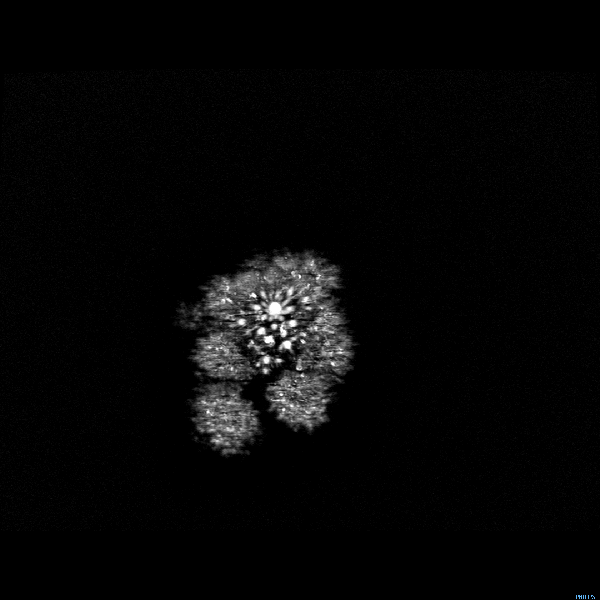Exotic Fruit
As art or science, MED tech’s MRIs enchant
These elegant images were created by Andrew Ellison, chief research MRI technologist at the School of Medicine, who creates them by scanning fruits and vegetables. Photo by Cydney Scott
It began with an orange. As chief research MRI technologist at the School of Medicine, Andrew Ellison is entrusted with costly, sophisticated scanning equipment that he must warm up and calibrate for accuracy day after day. Since MRI (magnetic resonance imaging) is a diagnostic tool that looks at soft tissues, Ellison decided on a whim one day to do one of these routine test scans on a piece of fruit. The resulting image of an orange was so stunning he began scanning other fruits and vegetables, including a strawberry, an artichoke, a pomegranate, an ear of corn, celery root, and a tomato. He then posted them on Reddit. Seen anew through this rare lens, they are works of art.
“We were testing different protocols and parameters and wanted something a little more complicated than a bottle of water, which we’d been using as a so-called phantom,” recalls Ellison, who graduated from Suffolk University in 2007 with a degree in biology and has been working at BU for seven years. “So we scanned an orange, and I was like, wow, that looks really cool, and from then on out anytime I needed to do quality assurance on the machine I would use a different type of fruit rather than a boring phantom.”
Almost immediately after he created those first images in spring 2008, Ellison found his work drawing attention from both the science and the food worlds. Within months, the images, and animations he crafted from them, were showing up in media from Science to Bon Appetit to Business Insider. A July 2010 story invited Salon.com readers to look “into the soul of fruit with MRI scans.” That same year, Science ran a short piece about Ellison titled “Art from Produce,” and a National Public Radio story focused on his “ghostly produce.”
 Ellison created this animation from MRI scans of broccoli. Image courtesy of Andrew Ellison
Ellison created this animation from MRI scans of broccoli. Image courtesy of Andrew Ellison
More recently, Discovery.com showcased his images in an October 2012 feature: “MRI Undresses Fruits and Vegetables.” To date, Ellison has scanned more than 60 fruits and vegetables. The images now live on his popular blog.
Prints of the black-and-white images also adorn the halls of the corridor outside Ellison’s office, where he often toils alone. A cross section of a pineapple is reminiscent of a shadowy X-ray of a human chest. The folds of an artichoke seem reflected in water, and a slice of pomegranate could be mistaken for a microscopic glimpse of a living cell.
“It’s interesting; I didn’t have the foresight to see this going in as big a direction as it went,” says Ellison, who shares the images and GIF (graphics interchange format) animations for free. “I get huge hit numbers from foodies, artists, and scientists, so the blog sits very happily in this realm of big internet hit generators.” The blog images get thousands of hits from US viewers each month, as well as from as far away as Mexico, Indonesia, Hungary, Russia, Spain, Australia, and the Netherlands, where one of his fruit scans was used in a poster for an Amsterdam food festival.
Unlike the busy MRI unit down the road at Boston Medical Center, the MED unit is exclusively for research, so there’s a lot of downtime, and scanning fruits is a good way to keep the machine active, Ellison says. To scan the fruits, he freezes a series of 10 to 15 images the thickness of a millimeter or less. “It’s a good way to make sure the machinery can keep up to the level it needs to be at, because there are about 40 different pieces of equipment that all need to be in working order,” he says of the Philips Tesla MRI, which is used on animal as well as human subjects.
His creations have drawn the attention of the MRI manufacturer as well. “Philips has a publication, and they gave me a whole-page spread,” says Ellison, who has begun “experimenting for the sake of art.” His latest forays involve using thick fruit and vegetable slices, which, he says, “look wicked cool.”
This BU Today story was written by Susan Seligson. Slideshow by Kristina Roman (COM’08)
View all posts